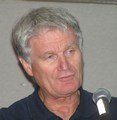Convening for Action Partnerships are Turning Ideas into Action in B.C.

“The Water Sustainability Committee believes it is simply not good enough to focus only on defining the problems or debating the perspectives (the ‘so what’). Rather, the objective of the Action Plan is to challenge individuals and organizations to demonstrate how we can move from talk to action (the ‘now what’),” stated Erik Karlsen. “The desired outcome is implementation of on-the-ground changes in policies, programs, research, practitioner education and standards of practice that lead to full integration management and landscape (re)development. In an ‘integrated landscape’, water is the unifying element.”
Coming Soon: CAVI – Leadership in Water Sustainability
Coming Soon: Vancouver Island Symposia Series
Coming Soon: Water Balance Model for British Columbia
Water OUT = Water IN: Penticton Workshop in April 2005 Launches Convening for Action initiative for ‘Achieving Water Balance’

“The 2005 Penticton Workshop was the first regional event organized under the Convening for Action umbrella. The workshop was organized in two parts and the presentations were cascading in order to elaborate on the OUT = IN theme,” reported Kim Stephens.
“Water – Our Limiting Resource” – Towards Sustainable Water Management in the Okanagan

“The water resources of the Okanagan Basin are a limited resource that is already heavily allocated to present uses. To move toward sustainable water management in the Okanagan Basin requires difficult decisions now that will include reducing demand to new governance models that consider the basin as a whole, and to more pro-active management,” stated Brian Guy.
“Convening for Action in British Columbia” launched at Okanagan Conference in February 2005

“The Water Sustainability Committee of the British Columbia Water & Waste Association (BCWWA) provided the core content for Day Three. his positioning fitted well with our convening for action mantra: What / So What / Now What. Our team of Oliver Brandes, Lynn Kriwoken and Kim Stephens provided the Now What part of the program,” reports Ray Fung.
“Convening for Action in British Columbia” initiative: links to downloadable versions of PowerPoint presentations

“The Kelowna conference was an important first step in focusing stakeholder attention on the decisions that need to be made now if we are to move towards sustainable water management in BC. Inter-association collaboration is an essential ingredient if collectively we are to create the province-wide momentum that will result in substantive change related to water management and use,” stated Don Degen.
Water Balance Management in the Okanagan: Now What Do We Do?

“The paper suggests expanding the application of the Water Balance Model approach to all land uses in the Okanagan, and in particular agriculture. In the urban environment, the main focus is on the individual development site because what we do at the site scale can create opportunities for cumulative benefits over time,” explains Kim Stephens. “In applying the water balance philosophy to the Okanagan in its entirety, the proposed paradigm would be: ‘the Basin is the site’.”
A New Water Management Paradigm: The Soft Path

“Water management can be viewed on a continuum (or spectrum) that includes three distinct approaches: supply-side, demand management, and the “soft path”. There is a growing awareness of the need to talk in these terms. Furthermore, this awareness is helping to focus attention on what practitioners can do to turn ideas into action,” says Oliver Brandes.

